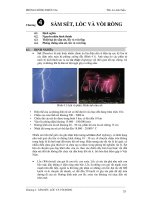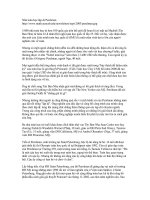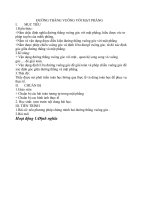Tài liệu Heavy Construction Lecture #11 - Brick Masonry doc
Bạn đang xem bản rút gọn của tài liệu. Xem và tải ngay bản đầy đủ của tài liệu tại đây (14.65 MB, 39 trang )
Heavy Construction
Heavy Construction
Lecture #11
Lecture #11
Brick Masonry
L Prieto-Portar 2008
A brief background of masonry.
Before writing was invented, cities in the Indus valley and in Sumer (present Iraq) had
developed sophisticated masonry. The Sumerians built tall buildings seven stories high
with baked clay bricks (circa 4,000 BC). They were the Biblical builders of the ill-fated
tower of Babel, also built with masonry, which was a city situated 20 miles south of
present-day Baghdad. Further development of masonry were brought forth by the
Babylonians, Egyptians and ancient Chinese. Many of their structures are still standing.
The Romans perfected the use of masonry with their bridges, aqueducts and their domes.
These domes (the Pantheon was the world’s largest until recently) were the extension of
their knowledge of the semi-circular arch expanded into three-dimensions made entirely
with masonry. It is interesting to note that the Middle ages lost much of Rome’s
technology except for masonry. Brunelleschi's dome in Florence for the Santa Maria di
Fiori church became the world’s largest dome, made entirely from masonry and built
without scaffolding!
Since prehistoric times up until the mid-1800s
wood, stone and masonry were the primary
building materials. However, by the late 1800s two new products had been developed:
structural steel and reinforced concrete. Masonry has taken a secondary role ever since,
primarily because it is very labor intensive, wall heights are limited and their weight
required large and expensive foundations. A modern variant to the brick is the concrete
masonry unit (CMU), which has reduced the cost of masonry for residential construction.
During the later 20th century an improved “older” material became popular: steel
reinforced masonry. It provides a better structural support to weight ratio, with an
improved resistance to severe weather.
Another new product is the use of high strength mortars. These mortars not only were
capable of greater wall heights, but provided an improved resistance to the elements.
The masonry units were also improved, with
high strength masonry units, which came
in a great variety of sizes, colors, textures and coatings, thereby providing an
improved architectural product.
Primary uses of masonry today.
Concrete masonry units (CMU) are commonly used for foundation walls of residential
units, as well as for the actual structural support walls (low rise) of retail malls,
hotels, schools and other commercial projects. Many residences in high wind areas
(like South Florida) prefer reinforced-CMU residences.
CMU are also used as the structural backup walls for non-structural exterior facings,
such as decorative panels of glass, brick and stone. The exterior face become the
wearing surface and provides an architectural appearance.
CMU foundation walls
CMU structural walls on a low-rise building.
Reinforced structural CMU walls.
This CMU structural wall is serving as a “backup” wall for a brick facing.
Brick masonry.
Both brick and decorative CMU walls.
Brick masonry ‘mosaic’.
The functions of mortars.
Mortars provide a level and full bearing surface for masonry units, and thereby carry
the units’ irregular surfaces on a cushion of high strength material. The mortar also
provides a seal against water between the masonry units. This seal is a structural bond
that ties all the units into a single structural element (the wall).
Finally, the masonry units provide visual aesthetics of the building, which is usually the
most important consideration for the architect and the owner of the building.
The uniqueness of brick masonry.
- Brick masonry units are the most resistant masonry to fire.
- Bricks are small, easily hand held, easy to lay and flexible to adapt to difficult
geometries.
- Bricks are extremely durable. Sumerian bricks have survived for over 5,500 years in
structures that are still standing today.
- Bricks are resistant to weather, they do not rot, are not affected by insects, and never
need painting or maintenance.
Note that the joint color “blends” with the brick’s color.
Blended joints.
These joint’s color is contrasted with the brick’s color.
Mortar’s ingredients.
1) Portland cement, same as used in concrete; serves as the bonding agent;
2) Hydrated lime, used to enhance the workability of the mix;
3) Sand, in a clean condition (not beach sand) and graded (different sizes);
4) Water, should be clean (that is, potable); and
5) Admixtures, which may be optional; they usually are used to make the mixture
more workable (easier to mix), or retards the setting time, or accelerates the setting
time, etc. These products come in a prepared package suitable for each sack of
cement. They also include color for different uses.
Pre-packaged mortars.
Pre-packaged mortars are ready to use, and require only adding water. They
commonly include the cement, sand and lime. They are offered with a variety of
colors (although grey is by far the most common). The curing of the mortar takes
place by hydration, which is a chemical reaction, and not by drying. As soon as the
mix receives the water, the chemical hydration starts, and the mortar can only be
plastic for re-tempering during 90 minutes. After 2 hours it must be discarded.









